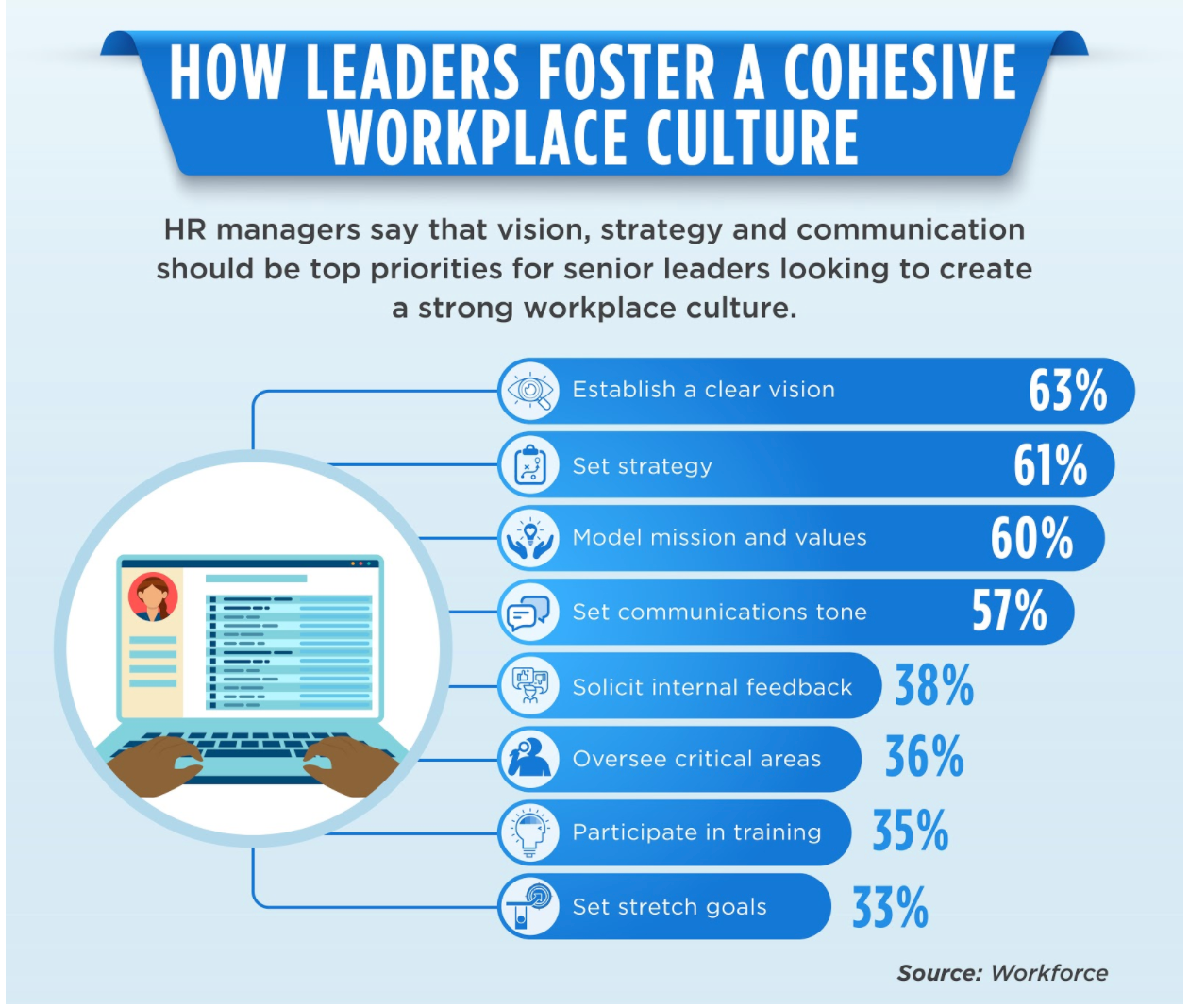Establishing a positive workplace culture: definition, tips & why it's important
Happiness at work is about so much more than the tasks that are completed. It’s also about fitting into the organisation and feeling aligned with the business’s values, vision and work style. In other words, driving business success through culture.
Workplace culture — the qualities that make up a business and dictate how people within it should think, act and work together — is an incredibly important part of an individual’s success at work. It is also essential to the success of the business. When workplace culture is deliberately defined by an organisation and is actively worked upon, the business thrives. When culture is left to its own devices, disharmony can result.
Read on to discover how to create and sustain a positive workplace culture, gain insight into the challenges of a negative or toxic culture, and what human resources (HR) professionals can do to support the process of changing culture.
What is workplace culture?
Workplace culture is the overall character of the business. Often unique to the organization, workplace culture can include elements such as the business’s values, beliefs, behaviors, goals, attitudes and work practices.
Ideally, businesses want to create a culture that is viewed as positive. A company could accomplish this by focusing on innovation, flexibility or empowerment. On the flip side, a company’s culture could be seen as negative when it is hierarchical, bureaucratic or power-driven.
What affects workplace culture?
On the surface, creating and sustaining a positive workplace culture may seem simple. But as businesses grow and different personalities come into the organisation, positivity can quickly turn to toxicity. The following factors influence workplace culture at any given business:
Leadership and management
Even without realising it, business leaders play a major part in influencing workplace culture. Employees within an organisation look up to leaders and use their behaviour as a guide for how they themselves should act. For example, if an organisation says that wearing formal workplace attire is important, yet the leaders themselves never dress formally, it will soon be seen as ‘culturally acceptable’ to wear more casual dress.
Company policies and value statements
Organisational vision and mission statements, and the policies that support them, can influence culture insomuch as leaders and employees embody and abide by them. For example, an organisation aspiring to be diverse and inclusive may implement strategies to attract and retain more diverse employees. These values and policies would positively influence hiring and, in turn, workplace culture.
Workplace practices
HR practices such as recruitment, onboarding and promotional processes can be a large determinant of workplace culture. Reward and recognition programs and job flexibility policies also influence culture. These practices may result in a business having a family-friendly culture, if it provides flexible work-life balance options and gives generous paternity leave, or an ‘up or out’ culture, where if you don’t get promoted, you’re encouraged to leave, for example.
People
Hiring people with different backgrounds, skill sets, values and beliefs will undoubtedly influence the nature of the workplace. The type of personalities you hire may produce a culture that is collaborative and supportive or, on the other end of the spectrum, combative and competitive.
Workplace environment
The work environment that you establish can have a bearing on culture. For example, perhaps all of your staff members work remotely, only dialling into calls when they’re needed. This structure creates a flexible, task-focused culture. Alternatively, you might decide to have an open-plan office, which can create a more social and collaborative workplace culture.

The characteristics of a positive workplace culture
Positive workplace cultures do not happen by accident — they have certain characteristics that are deliberately planned and managed by the organisation’s leadership and HR teams. Characteristics of a positive workplace culture can include:
Purpose-driven company culture
Fundamentally, most businesses exist to turn a profit. Yet this alone is not inspiring to employees. People within organisations want to feel like they are part of something meaningful.
For example, a running shoe business might aspire to be the biggest and best in the market. But this aspiration may not be enough to create a positive culture. To create a sense of purpose, the business could build a workplace culture around what employees can give back to society, such as helping people stay fit and healthy through running.
Effective communication
Having a purpose-driven mission in a business is ineffective unless you can communicate it properly. Effective communication is the cornerstone of all positive workplace cultures.
With effective communication, all employees understand the goals of the business and how they contribute to them. They understand how to work within the business and what the business expects of them. For example, effective communication may involve all-hands-on calls with the organisation’s leadership, as well as regular team meetings where everyone is updated on the business’s goals and positions. Regular communication may also involve an intranet site with up-to-date business information.
Without effective communication, employees may feel disconnected, jaded or cynical. They may be unsure of their responsibilities or may simply feel as if they are only working for money. This can result in employees avoiding any discretionary or innovative work. These feelings and behaviours can detract from a positive workplace culture.
Workplace communication resources
The following resources can help you further improve workplace communication:
Effective communication in the workplace: How and why?, HR Technologist
10 Steps to Improve Your Workplace Communication Skills, The Job Network
Workplace Communication: Ideas to Improve Communication at Work, SHRM
A culture of feedback
Within any organisation, things will inevitably go wrong: people will make mistakes, leaders will do things they shouldn’t and the business will face performance challenges. But establishing a culture of feedback can help reduce the chance of errors and build confidence in employees.
A culture of feedback means that when mistakes are made, people are informed, early and often. Employees feel that mistakes are acceptable, as they are always given an opportunity to improve. If a culture of feedback isn’t established, people will become fearful of making mistakes and won’t try new things. They may start to fear routine job tasks, causing productivity to be stalled.
Diversity
When hiring for ‘cultural fit’ within a business, many people think that hiring people with the same values, beliefs and ideas is what makes a positive workplace culture. But this simply isn’t true. Diversity across all categories — including gender, religion, age, race, ethnicity and culture — are critical to establishing positive work environments. Without these, businesses risk losing important innovations, ideas and perspectives.
There are many positive steps you can take to promote diversity within your organisation. These actions include asking for ‘blind’ resumes (requesting that gender- and race-identifying information, such as names, are removed), as well as having shortlist quotas for certain characteristics.
Workplace diversity resources
The following resources provide more information on fostering workplace diversity:
How to create a diverse workplace culture, Forbes
6 Steps for Building an Inclusive Workforce, SHRM
5 Ways to Improve Workplace Diversity, Zippia
5 Things We Learned About Creating a Successful Workplace Diversity Program, HBR
Teamwork
Workplaces with positive cultures are often made up of diverse leaders and even more diverse individuals. But despite their different perspectives, they all have one thing in common: They work well together.
There are a number of tools you can use to facilitate teamwork. These include online technologies, such as Slack and Yammer, where staff can collaborate and share information effectively. Regular team meetings and a culture of ongoing feedback within an organisation also help foster successful teamwork.
Engagement and loyalty
At their core, positive workplace cultures are environments where people like coming to work. When people are engaged in their roles, they feel as if they are contributing and making a difference.
This feeling causes them to put extra energy into completing job tasks, a phenomenon called discretionary effort that can result in boosted productivity. When people feel engaged and empowered, they are also more likely to stay with an organization. Employee engagement can be fueled by positive-role-model behaviours in leadership and through HR recognition programs.
Growth and development
In addition to feeling as if they have a higher purpose at work, people also want to feel as if they are learning, growing and developing new skills. Few people want to do the same job without change for long periods of time.
Growth and development, both personally and professionally, are a big part of a positive workplace culture and should be fostered using formal and informal training, such as courses, job shadowing or mentoring.
Employee growth and development resources
Learn more about employee growth and development with these resources:
8 Key Tactics for Developing Employees, Forbes
10 Ways to Develop Employees, The Balance Careers
How to Support Employee Growth and Professional Development, Glassdoor

How to define a company’s workplace culture
Learning about the characteristics that create a positive culture is an important first step in creating an enviable work environment. After gaining knowledge of these traits, some companies will simply strive to adopt certain characteristics without stepping back and actually defining their culture. This is a mistake.
In order to create a positive work setting, you need to define what you want your workplace culture to be. Business leaders and HR managers should examine questions such as:
- What is our vision?
- What are our values?
- What policies and practices are important to us?
- How do we want employees and leaders in this business to behave?
- What are our goals, and what work practices will achieve them?
Answering these questions will help you assess your current culture and make a plan for positive change.
The importance of a positive workplace culture
Anyone who has worked in an organisation with a toxic or negative culture will know that it is not a pleasant experience. But why, exactly, are positive workplaces so important? Some of the reasons include:
Staff retention
Regardless of the product or service delivered, all businesses need people to maintain operations. As such, people are the most important assets of organisations, and retaining talent is among the highest priorities of most executive teams.
Companies with positive workplace characteristics — such as strong diversity, feedback, and growth and development policies — are far more likely to be able to retain talent. These characteristics help keep people satisfied at work and encourage employees to establish long-term careers with the company.
Brand identity
In order to retain great talent, organisations need to attract it in the first place, and workers are often attracted to companies with a strong brand identity. A brand identity is how businesses are perceived by the public and potential employees, and it can greatly influence what positions an individual applies for. Everyone wants to work for a business that has a positive workplace culture, and such cultures become a part of an organisation’s brand identity.
The importance of culture goes beyond simply attracting great people. Great cultures shine through into great products and services, which contributes to a positive business performance and an even stronger brand identity.
Employee expectations
Workplace culture is not something you can see or even something that new employees read about. Yet all companies have one, and it can significantly affect the expectations of new and existing employees.
For example, say that in an interview, you set the expectation for a candidate that your organisation values work-life balance. Yet when the new employee starts work, they see everyone around them putting in 10- to 12-hour days, as this is the prevailing workplace culture. Quickly, the new employee will start to believe that they too are expected to work 10- to 12-hour days.
Different types of workplace cultures affect employee expectations in different ways. And different groups of employees may have different expectations. For example:
Startup culture
A startup culture — the workplace style that began in startup companies and now is used in numerous types of organisations — comes with its own unique characteristics.
A business is said to have a startup culture if it values open communication, creativity and innovation, as well as the lack of a formal management structure. Employees who work in a startup culture can expect to have greater job flexibility and a more informal approach to interacting with leaders.
Millennials
Just as those who work in startups bring their own set of expectations to a business, so too do millennials.
Research has shown that millennials have different expectations of workplace culture than previous generations. In general, millennials put more focus on working for a mission-driven organisation and expect work to be inspiring and fulfilling. They also expect collaboration, and they are increasingly rejecting workplaces that are too hierarchical and bureaucratic.
Workplace culture challenges and toxic workplace culture
Creating and maintaining a positive workplace culture can be challenging. If you don’t define your culture and continually work on it, negative or toxic cultures can arise on their own. But what causes this? Here are some of the factors that can contribute to cultural challenges or downright toxic workplaces:
Established negative workplace attitudes and practices
Admittedly, workplace cultures are easier to build than they are to change. This is because change of any type is always challenging, especially if it involves adjusting ingrained behaviours or expectations.
Say, for example, you were attempting to change from a bureaucratic culture to a startup culture. This would include fundamentally adjusting people’s expectations, habits and work styles, and your new culture may no longer align with everyone’s values. This change may be difficult if workers have established negative attitudes over time while working in the bureaucratic structure.
Multigenerational workplaces
With the advent of the internet and increasing globalisation, the last few decades have seen an extraordinary amount of change in workplaces. This has resulted in different work expectations for different generations, which in turn can create disagreements among coworkers.
A common example of this is the expectations of baby boomers (those born in the years after the Second World War) versus the expectations of millennials (people reaching adulthood at the start of the 21st century). Typically, baby boomers expect work to be hierarchical, and as such expect seniority to come with years of experience. Millennials, on the other hand, believe in a more flat workplace structure.
Conflict and tension
Conflict and tension are normal in any workplace. When major projects are in the works or new procedures are being established, there will typically be disagreements over the best way to accomplish goals. But if there is too much conflict and tension, or if the tension is constant, this can create a negative workplace culture that is difficult to change.
Unmotivated or dissatisfied staff
Unmotivated or dissatisfied staff have the ability to severely affect even the most positive workplace cultures. If a staff member is dissatisfied with work procedures or management decisions, they will usually tell everyone around them and will be less motivated to complete good work. This may result in lost productivity or frustration on behalf of their team and their stakeholders.
Changes in traditional workplace expectations or practices
Managing change is one of the biggest challenges facing organisations today.
One large change that many organisations are experiencing at the moment is digital transformation, such as replacing a call centre or store with an online experience. Other changes might include a CEO change or a departmental restructuring. These fundamental changes can disrupt jobs and may require a large-scale adjustment in attitudes and behaviours. If not everyone accepts the change, a toxic workplace culture can result.
How to change workplace culture
Fortunately, it is possible to change negative cultures to positive ones. These changes are guided by the company’s management and its HR team. If you need to adjust your workplace culture, the below steps can help guide you through the process:
1. Evaluate the company and its current culture
Understanding your current culture is the first important step to changing it. In order to evaluate your current workplace culture, answer the following questions:
- What is our current working style?
- What behaviours do leaders and employees display?
- What policies have been put into practice?
- What values seem to be important?
2. Define the values and strategic direction of the company
After you have defined your current culture, the next step is to define the values and the strategic direction of your company. For example, you may have discovered you have a hierarchical, toxic culture, but your organisation wants to transform to a more startup-like culture. Or you may want to focus your values more closely on improving customer service.
Your workplace culture needs to align with what your organisation wants to achieve in the future and what it deems as important, so ensure you understand these elements in detail.
3. Make behavioural changes at an individual level
Your workplace culture is not separate from the people within your organisation. If you want to enact change, you will need to help people make behavioural changes at an individual level.
Say, for example, you’ve identified that one of your values is work-life balance, but everyone in the business is currently working 12-hour days. One of the first behavioural changes you would need to make as an HR professional would be to encourage leaders to work only eight hours each day, so that this behaviour can cascade down through the organisation.
4. Provide training and support
Workplace culture, just like the behaviours that support it, can’t be changed immediately. If you want your cultural change to progress, you will need to provide leaders and employees with continual training and support. This might include individual training programs to make sure that workers accept new processes, or it may include team-building activities to foster a sense of collaboration.
Examples of successful positive workplace cultures
Positive workplace cultures are all around us. They exist in the world’s biggest companies, and they endure in the smallest firms as well. Here are a few examples of inspiring and positive workplace cultures:
Salesforce
Salesforce is well known for its extremely positive and uplifting workplace culture, which is centred on the idea that all employees can ‘blaze their own trails’ with the company while putting Salesforce’s customers at the centre of everything they do.
Salesforce is intentional and overt about the culture of trust it has built. The firm empowers every employee, from the most junior to the most senior, to grow their careers, improve their communities and be their best selves. Salesforce has a clearly defined set of values and clear behaviours that the firm’s leaders expect everyone to aspire to.
Hilton
Hilton is another great example of a positive workplace culture that was created by design. Hilton’s mantra is simple: If we invest in our people, they will provide our guests with the best service.
As such, the company has built a culture around great training, development and career support for all employees. Hilton provides industry-leading benefits and treats every staff member as one of the family.
Accenture
One of the world’s most recognisable professional services brands, Accenture is well known for its positive workplace culture.
Known particularly for its focus on celebrating the unique qualities of each and every person, Accenture is also a leader in the diversity space. The company has made bold targets when it comes to gender diversity, and it aims to have a completely gender-balanced workforce. In order to foster innovation, Accenture also creates an empowering environment for bold leadership.
The future of workplace cultures
Workplace cultures are changing and evolving, and businesses in the future will look increasingly different from how they appear now. Specifically, workplaces of the future will include:
Diversity and inclusion
Diversity and inclusion is becoming a need-to-have quality for organisations to succeed. Communities and political leaders increasingly expect businesses to reflect the customers they serve in terms of who they hire and who they choose to lead.
Effective work spaces and flexibility
Like diversity, flexibility is fast becoming a requirement for all organisations. Technology is more accessible, and people are working collaboratively on a global basis. As these trends grow, people will expect businesses to offer flexible work-life options and efficient work spaces.
Adaptability to workforce changes
With increasing amounts of artificial intelligence being used by businesses, and with automation and robotics replacing many jobs, one of the key challenges in future workplace cultures will be the need to accept even more change in how things are done. People will need to be adaptable to create a positive workplace culture.
Sustaining workplace culture through HR policies
Creating a positive workplace culture can make or break an organisation’s success. Yet at the same time, it isn’t something that can simply be accomplished and then left unattended. A positive workplace culture can only be maintained through sustained efforts by the HR and management teams.
Drive business success through culture with RMIT Online's Master of Human Resource Management.






